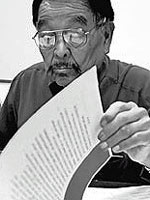
50 Years Ago: Positive national attention follows 2 Diné
As 1971 ended, two prominent Navajos received good news giving them more power and prestige.

Dr. Taylor McKenzie
The first was Dr. Taylor McKenzie, who was probably next to Peter MacDonald and Raymond Nakai the most revered member of the Navajo Tribe. And unlike the two tribal leaders, McKenzie was well liked by both political factions.
It’s hard to explain today just how revered McKenzie was in 1971. He was the first Navajo to become a doctor at a time when few Navajos were even taking courses to become a nurse.
McKenzie would bring this up pointing out that teachers on the reservation in the 1950s, most of whom were non-Navajo, very seldom pushed their students to seek degrees in medicine and law.
But McKenzie was fortunate in getting teachers at the Navajo Methodist Mission School who recognized his potential and pushed him to take advanced classes. This pushing persuaded him go to the Baylor University School of Medicine. And to top it off, he spent an extra two years learning how to be a surgeon.
By 1971, he had been a surgeon for the Indian Health Service for seven years as an officer in the Public Health Service, serving stints at Kayenta and Tuba City before he was appointed in July 1970 to be director of the Shiprock facility.
He learned in December 1971 that he was being promoted to the director level at the PHS, which is comparable to being a full colonel in the Army.
Even at this level, however, he would be making less than half what he would make in the private sector. And with nine children, the extra money would have made life a lot easier for his family.
When his promotion was announced, McKenzie received national attention from the news media, and he said one of the questions was why he didn’t take advantage of his position and go into private practice.
“Most of our people can’t afford the high costs of private medical treatment,” he said. “I felt I could do my people more good by working for the Public Health Service.”
This position would cause him problems seven years later when he decided to run for tribal chairman against MacDonald and Nakai. MacDonald campaign officials privately worried that a general election having MacDonald and McKenzie on the ballot for chairman would be a toss-up.
So, the campaign actively tried to reduce McKenzie’s popularity in the primary by pushing the position that McKenzie was more needed as a doctor than as a tribal leader. It apparently worked because McKenzie ended up third in the primary even though he was expected not to have any problem getting more votes than Nakai.
2nd Diné
The second Navajo who received good news this month was Daniel Peaches, who was director of the tribe’s public affairs office.
Arizona Gov. Jack Williams announced that, beginning in 1972, Peaches would be named to the Arizona Commission on Indian Affairs, an advisory body that had a lot of influence in getting the state Legislature to pass laws ending discrimination against Native Americans and providing them with the same benefits as non-Indians.
MacDonald was the first tribal chairman who had someone in charge of public information. Previous chairmen saw no need for the position because no media organization seemed to care enough to report what was going on in the tribal government. Past chairmen let this function be handled by delegates of the Navajo Tribal Council who were expected to provide updates when they gave their monthly reports at chapter meetings.
News reporting did not have a good name in Navajo society with the Navajo word for newspapers referring to them as gossip, which could be viewed as the Navajo equivalent of “fake news.”
But when MacDonald took office that changed as national publications found their readers were interested in what was going on in Indian Country. The Gallup Independent even established a bureau on the reservation which had for many years two reporters writing stories from the reservation.
Peaches was perfect for this job. For many years he was featured regularly in the Times’ letters-to-the-editor section giving his thoughts and opinions on various issues affecting the Navajo people and government.
As public information director, he was tasked with the responsibility of making sure the local media reported everything his boss was doing for the Navajo people. He did this by releasing several press releases weekly and encouraged papers to meet not only with MacDonald but others in the government as well in their coverage of the reservation.
To do this, he formed friendships with many area reporters by being available seven days a week to answer any questions. He also answered questions from the national press.
As part of this responsibility, he often called up regional and national publications when they printed inaccurate information about the tribe.
For example, in 1972 or 1973, the Christian Science Monitor, which had a national readership, reported how much money was in the federal budget for building new homes on the reservation.
One statement the article said 60% of homes on the reservation consisted of traditional teepees. To show rugs, the paper included a photo of a teepee on the reservation. The photo was of a teepee put up temporarily for a Native American Church Ceremony.
Peaches immediately sent a letter to the newspaper pointing out their error. He also put out a press release to local media using this as an example of national reporters not making any effort to make sure their reporting on Native Americans is accurate.







 Highway 264,
Highway 264, I-40, WB @ Winslow
I-40, WB @ Winslow